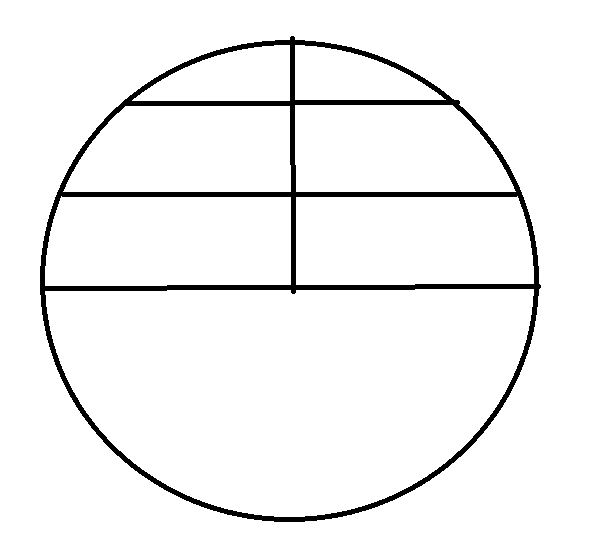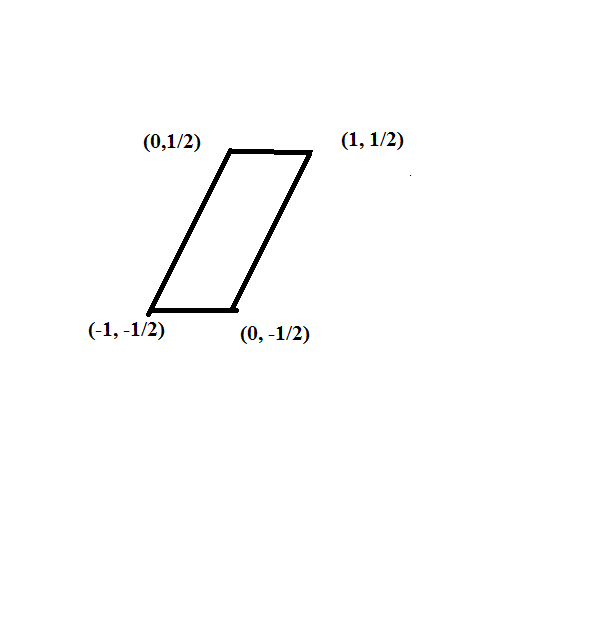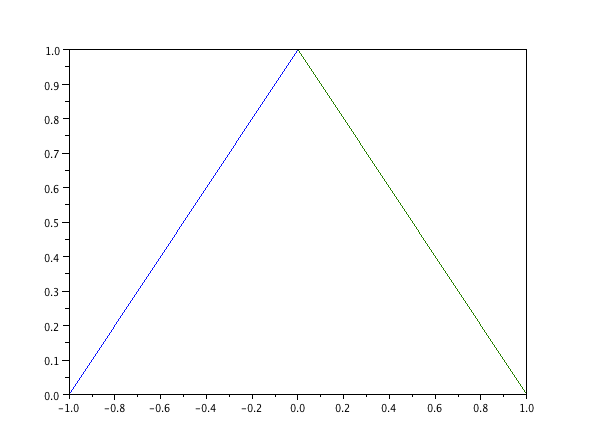I am always looking for interesting calculus problems to demonstrate various concepts and perhaps generate some interest in pure mathematics.
And yes, I like to “blow off some steam” by spending some time having some non-technical mathematical fun with elementary mathematics.
This post uses only:
1. Integration by parts and basic reduction formulas.
2. Trig substitution.
3. Calculation of volumes (and hyper volumes) by the method of cross sections.
4. Induction
5. Elementary arithmetic involving factorials.
The quest: find a formula that finds the (hyper)volume of the region 
We will assume that the usual tools of calculus work as advertised.
Start. If we done the (hyper)volume of the k-ball by  we will start with the assumption that
we will start with the assumption that  ; that is, the distance between the endpoints of
; that is, the distance between the endpoints of ![[-R,R]](https://s0.wp.com/latex.php?latex=%5B-R%2CR%5D+&bg=ffffff&fg=000000&s=0&c=20201002) is
is  .
.
Step 1: we show, via induction, that  where
where  is a constant and
is a constant and  is the radius.
is the radius.
Our proof will be inefficient for instructional purposes.
We know that  hence the induction hypothesis holds for the first case and
hence the induction hypothesis holds for the first case and  . We now go to show the second case because, for the beginner, the technique will be easier to follow further along if we do the
. We now go to show the second case because, for the beginner, the technique will be easier to follow further along if we do the  case.
case.
Yes, I know that you know that  and you’ve seen many demonstrations of this fact. Here is another: let’s calculate this using the method of “area by cross sections”. Here is
and you’ve seen many demonstrations of this fact. Here is another: let’s calculate this using the method of “area by cross sections”. Here is  with some
with some  cross sections drawn in.
cross sections drawn in.

Now do the calculation by integrals: we will use symmetry and only do the upper half and multiply our result by 2. At each  level, call the radius from the center line to the circle
level, call the radius from the center line to the circle  so the total length of the “y is constant” level is
so the total length of the “y is constant” level is  and we “multiply by thickness “dy” to obtain
and we “multiply by thickness “dy” to obtain  .
.
But remember that the curve in question is  and so if we set
and so if we set  we have
we have  and so our integral is
and so our integral is 
Now this integral is no big deal. But HOW we solve it will help us down the road. So here, we use the change of variable (aka “trigonometric substitution”):  to change the integral to:
to change the integral to:
 therefore
therefore
 where:
where:

Yes, I know that this is an easy integral to solve, but I first presented the result this way in order to make a point.
Of course, 
Therefore,  as expected.
as expected.
Exercise for those seeing this for the first time: compute  and
and  by using the above methods.
by using the above methods.
Inductive step: Assume  Now calculate using the method of cross sections above (and here we move away from x-y coordinates to more general labeling):
Now calculate using the method of cross sections above (and here we move away from x-y coordinates to more general labeling):

Now we do the substitutions: first of all, we note that  and so
and so
 . Now for the key observation:
. Now for the key observation:  and so
and so 
Now use the induction hypothesis to note:

Now do the substitution  and the integral is now:
and the integral is now:
 which is what we needed to show.
which is what we needed to show.
In fact, we have shown a bit more. We’ve shown that  and, in general,
and, in general,

Finishing the formula
We now need to calculate these easy calculus integrals: in this case the reduction formula:
 is useful (it is merely integration by parts). Now use the limits and elementary calculation to obtain:
is useful (it is merely integration by parts). Now use the limits and elementary calculation to obtain:
 to obtain:
to obtain:
 if
if  is even and:
is even and:
 if
if  is odd.
is odd.
Now to come up with something resembling a closed formula let’s experiment and do some calculation:
Note that  .
.
So we can make the inductive conjecture that  and see how it holds up:
and see how it holds up: 

Now notice the telescoping effect of the fractions from the  factor. All factors cancel except for the
factor. All factors cancel except for the  in the first denominator and the 2 in the first numerator, as well as the
in the first denominator and the 2 in the first numerator, as well as the  factor. This leads to:
factor. This leads to:
 as required.
as required.
Now we need to calculate 

To simplify this further: split up the factors of the  in the denominator and put one between each denominator factor:
in the denominator and put one between each denominator factor:
 Now multiply the denominator by
Now multiply the denominator by  and put one factor with each
and put one factor with each  factor in the denominator; also multiply by
factor in the denominator; also multiply by  in the numerator to obtain:
in the numerator to obtain:
 Now gather each factor of 2 in the numerator product of the 2k, 2k-2…
Now gather each factor of 2 in the numerator product of the 2k, 2k-2…
 which is the required formula.
which is the required formula.
So to summarize:


Note the following:  . If this seems strange at first, think of it this way: imagine the n-ball being “inscribed” in an n-cube which has hyper volume
. If this seems strange at first, think of it this way: imagine the n-ball being “inscribed” in an n-cube which has hyper volume  . Then consider the ratio
. Then consider the ratio  ; that is, the n-ball holds a smaller and smaller percentage of the hyper volume of the n-cube that it is inscribed in; note the
; that is, the n-ball holds a smaller and smaller percentage of the hyper volume of the n-cube that it is inscribed in; note the  corresponds to the number of corners in the n-cube. One might see that the rounding gets more severe as the number of dimensions increases.
corresponds to the number of corners in the n-cube. One might see that the rounding gets more severe as the number of dimensions increases.
One also notes that for fixed radius R,  as well.
as well.
There are other interesting aspects to this limit: for what dimension  does the maximum hypervolume occur? As you might expect: this depends on the radius involved; a quick glance at the hyper volume formulas will show why. For more on this topic, including an interesting discussion on this limit itself, see Dave Richardson’s blog Division by Zero. Note: his approach to finding the hyper volume formula is also elementary but uses polar coordinate integration as opposed to the method of cross sections.
does the maximum hypervolume occur? As you might expect: this depends on the radius involved; a quick glance at the hyper volume formulas will show why. For more on this topic, including an interesting discussion on this limit itself, see Dave Richardson’s blog Division by Zero. Note: his approach to finding the hyper volume formula is also elementary but uses polar coordinate integration as opposed to the method of cross sections.
be denoted by
, the number of new cases is
, the first derivative.
where
is positive.
which is what is being plotted on the y-axis. So with the change of variable we are letting
and our new function is
, which, of course, is a straight line through the origin. That is, of course, IF the growth is exponential.
. Then
In the case of linear growth we’d have
(constant) and for, say,
,
or a “concave down” function.
, the relationship between the number of cases and the new number of cases looks like
so our
which is a quadratic which opens down.
.
vs the
vs.









